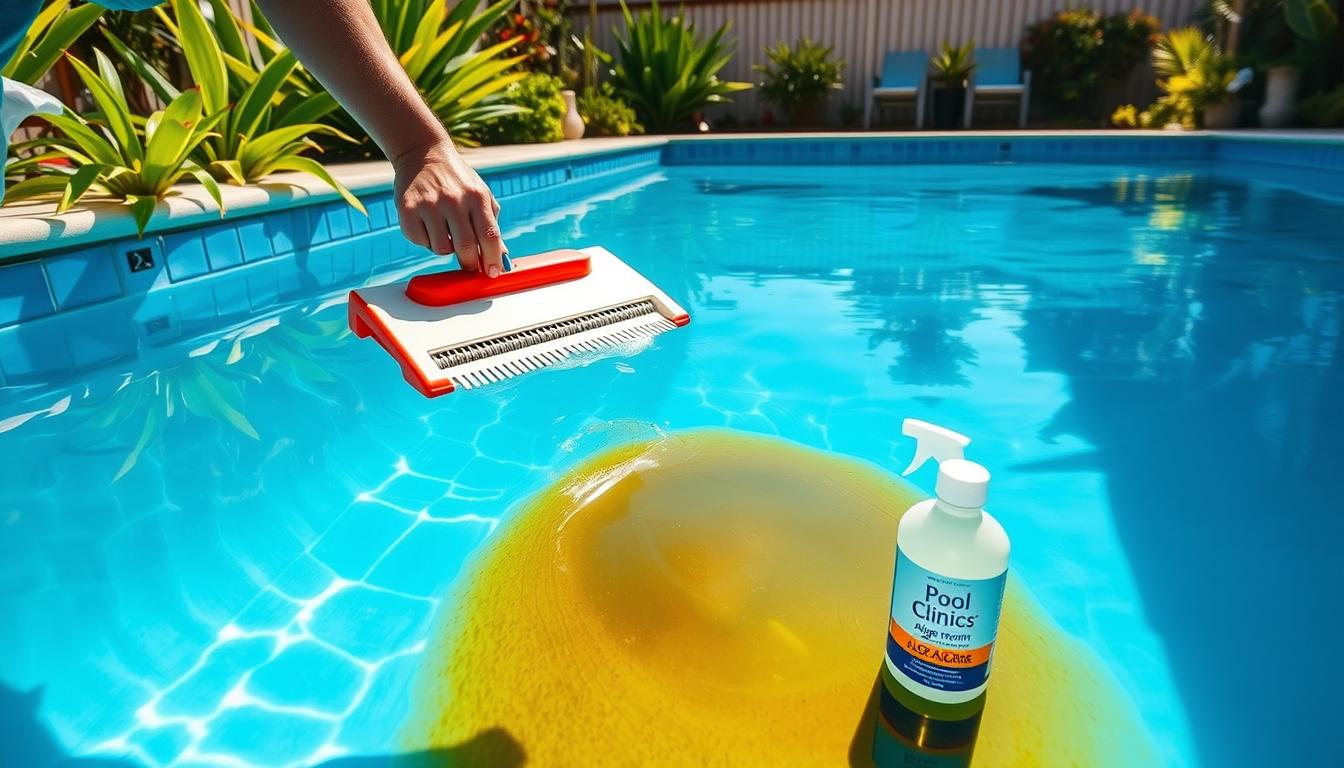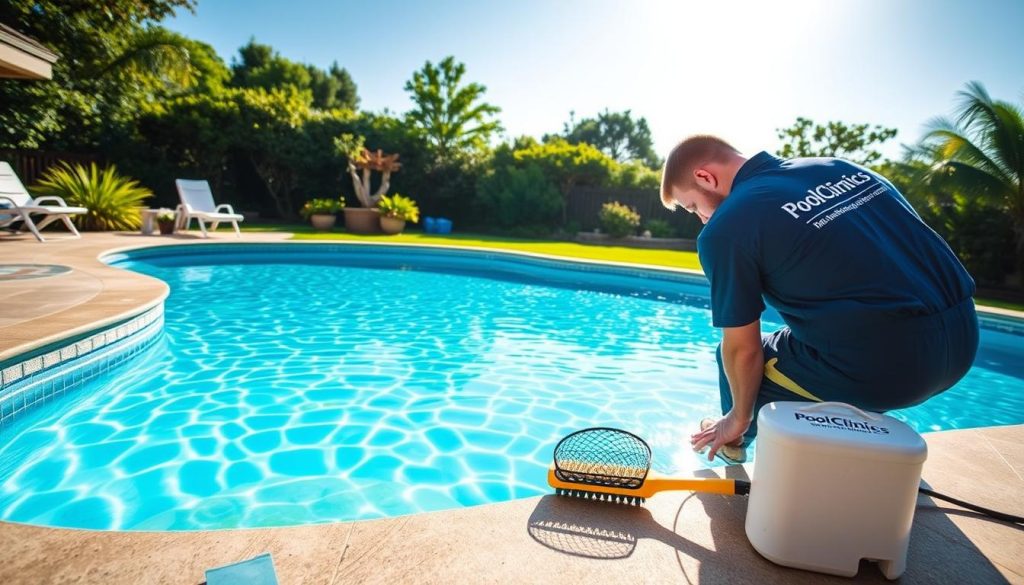
Noticed brown patches or slimy deposits on your pool walls? You’re likely dealing with brown algae. This common problem can turn your clear pool murky. Don’t worry! We’ll show you how to eliminate brown algae and restore your pool’s beauty.
Brown algae, or mustard algae, thrives in warm, nutrient-rich water. It’s more resistant to chlorine than green algae. This type of algae needs special treatment.
If ignored, brown algae can make your pool unattractive. It creates slippery surfaces and can harbor harmful bacteria. But with the right approach, you can control algae growth.
We’ll explore brown algae, its causes, and associated risks. You’ll learn how to remove it effectively and prevent future outbreaks.
Key Takeaways
- Brown algae, or mustard algae, is a resistant type of algae that can make your pool look unsightly and create health risks.
- Identifying brown algae early is crucial for effective treatment and preventing its spread.
- Maintaining proper water chemistry, regular brushing, and vacuuming are essential for controlling algae growth.
- Shock treatment and algaecide application are powerful tools for eliminating brown algae.
- Continuously running your pool filter and keeping it well-maintained helps prevent future algae blooms.
Understanding Brown Algae in Your Pool
Brown algae, also called mustard or yellow algae, is a common pool problem. It’s tough to spot and remove. Learning about brown algae helps us treat and prevent it effectively.
Brown algae can harm pool quality and safety. It’s crucial to understand its traits, causes, and risks. This knowledge helps us use pool algaecide treatment correctly.

Identifying Brown Algae
Brown algae looks like yellow or brown patches on pool surfaces. It can be mistaken for sand or dirt. Unlike slimy green algae, brown algae is harder to see.
Regular pool inspections are key. Check for unusual colors or growth. Early detection helps in killing pool algae faster.
Causes of Brown Algae Growth
Warm, still water and sunlight create perfect conditions for brown algae. Poor water circulation and filtration also contribute to its growth. Imbalanced water chemistry can fuel algae growth too.
Lack of maintenance leads to nutrient buildup. Nitrates and phosphates feed brown algae. Regular pool care helps prevent these issues.
| Type of Algae | Appearance | Common Locations |
|---|---|---|
| Green Algae | Slimy green spots or films | Pool walls and floor |
| Black Algae | Black or brown patches | Shaded areas or cracks in the pool |
| Mustard (Brown) Algae | Yellow or brown patches | Pool walls and floor |
Risks Associated with Brown Algae
Unchecked brown algae growth leads to various problems. It reduces water quality, making pools unsafe and unappealing. Brown algae can cause skin irritations and infections.
Algae growth can damage pool equipment too. This increases maintenance costs over time. Taking action early prevents these issues.
Prevent algae buildup with proactive steps. Test pool water regularly. Keep chemical balance in check. Use algaecides made for mustard algae. These steps keep pools clean and safe for everyone.
Step-by-Step Guide: How to Get Rid of Brown Algae in Pool
Brown algae can ruin your pool’s appearance. This guide will help you eliminate it and keep your pool clean. Follow these steps for a crystal-clear swimming environment.
Test and Balance Your Pool Water Chemistry
Start by testing your pool water with a reliable kit. Check pH, alkalinity, and sanitizer levels. Adjust these parameters to the recommended ranges for optimal pool health.
Use the right chemicals to balance your pool water. This may include pH increasers, alkalinity boosters, or chlorine.
Brush and Vacuum the Pool Surfaces
Use a stiff-bristled brush to scrub pool walls, floors, and steps. Focus on corners and crevices where algae often hide. This dislodges the brown algae from surfaces.
After brushing, vacuum the pool thoroughly. This removes loose algae and debris, improving water clarity.
Apply Shock Treatment to Kill Brown Algae
Shock your pool to eliminate remaining algae and sanitize the water. Choose a high-quality shock product like calcium hypochlorite. Follow the manufacturer’s instructions for proper dosage.
Typically, use 1 lb. of shock per 10,000 gallons of water. Allow it to circulate before swimming again.
Use an Effective Algaecide Treatment
Add an algaecide designed for brown algae after shocking. This helps prevent future growth and maintains clarity. Products like Doheny’s Total Algaecide offer long-lasting protection.
Follow the product instructions for correct application and dosage.
Run the Pool Filter Continuously
Operate your pool’s filtration system for 24 to 48 hours after treatment. This removes dead algae and evenly distributes chemicals. Continuous filtration helps clarify the water effectively.
Clean and Maintain Your Pool Filter
Regularly inspect and clean your pool filter for optimal performance. Remove debris from the skimmer basket and pump strainer. Clean or backwash the filter as needed.
Follow the manufacturer’s guidelines for your filter type. A well-maintained filter is crucial for algae prevention.
| Algae Type | Characteristics | Treatment |
|---|---|---|
| Green Algae | Most common, vivid green color, spreads rapidly | Brushing, shocking, algaecide |
| Black Algae | Deep color, root-like structures, attaches firmly to surfaces | Brushing, high-dose shocking, specialized algaecide |
| Yellow (Mustard) Algae | Yellow or brown patches, resistant to chlorine | Brushing, shocking, algaecide, patience |
| Pink Algae (Bacteria) | Slimy, pinkish film, thrives in warm, stagnant water | Brushing, shocking, algaecide, improved circulation |
Regular maintenance is key to preventing brown algae. Follow this guide and keep up with pool care. Your pool will stay clean and inviting for family and friends.
Conclusion
A consistent pool care routine prevents brown algae growth. Regular maintenance keeps the pool clean and safe. Brushing, vacuuming, and emptying skimmer baskets remove algae spores effectively.
Balancing water chemistry creates an environment hostile to algae. Adding a quality algaecide provides extra protection. Follow the manufacturer’s instructions for best results.
Proper circulation and filtration are crucial for algae prevention. Run the pool’s pump and filter system for 8-12 hours daily. Regularly shock the pool to kill bacteria and algae spores.
Cover the pool when not in use to reduce sunlight exposure. This also keeps out debris containing algae spores. A proactive approach ensures a crystal-clear pool all season long.







